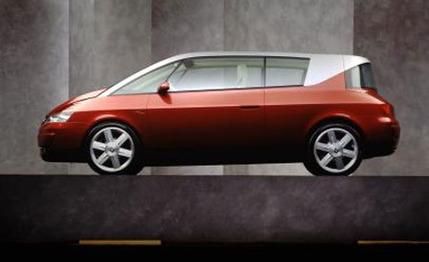
 Mini Test Road Test
Mini Test Road Test
Renault first presented its idea for a uniquely French "personal" car more than two years ago and has spent the time between trying to persuade us that its weird styling is the height of modern design. Remember, this is the same country that brought you Citroën.
To that end, Renault hooked up with the Guggenheim Museum in Bilbao, Spain, to associate its bizarre minivan/sports coupe Avantime with the avant garde.
The Renault Avantime is an extraordinary car: no doubt about that. Renault intended it to shock. Thierry Metroz, design project manager, said, "We wanted someone walking around the car to be continually astonished. When you look at the front, you can't imagine what the back will be like, and vice versa. The Avantime exploits those contrasts, between a figurehead of an animal and a solid, forceful stern." (Yes, he actually said "solid, forceful stern.")
Are there some parallels here with the Pontiac Aztek? You decide. To some, Renault's futuremobile is just plain ugly. Part of the difference is that GM doesn't present its excuses as elegantly. Nor is the Aztek as competent a vehicle as Renault's freak show.
You might ask how and why this all came about. It is best understood as a desperation move-again a parallel with GM? In recent times, European buyers have rejected big sedans and sports cars from the volume manufacturers and bought premium German brands instead, even if it meant having a smaller car with less equipment. The French volume carmakers suffered more than most. Renault's Safrane sedan, Alpine GTA, and Spider all lingered in showrooms until they just faded away.
So the answer, from design chief Patrick Le Quement, was to do something completely different-an amalgam of minivan and sports coupe. Do it right, and the BMW and Mercedes buyers might take a fresh look at Renault.
The minivan involved is the Espace, Europe's original multipurpose vehicle, which is made for Renault by Matra Automobile. The Avantime is front-wheel drive and shares most of its parts with the Espace. But whereas the Espace has a brilliantly adaptable interior and can seat up to seven, the Avantime is arranged with just four substantial chairs. As three-door cars go, it is spacious. Its doors are astonishingly long (and have to be double-hinged to allow entry and exit in confined spaces), and the pillarless sides, frameless windows, and huge glass sunroof give it an unusually light and airy feel.
So you sit high and have a good view. The two rear seats are mounted higher than the fronts, like a couple of thrones. They are not especially comfortable or supportive, and despite those enormous doors, the rear can't be reached without releasing the front seatbacks.
With a 204-hp, 2.9-liter V-6 engine, the only powerplant available initially, the Avantime will do nearly 140 mph and 0 to 60 mph in 8.5 seconds. But can something this shape and this tall be even slightly sporting and satisfying to drive? Surprisingly, it can.
Matra's engineers have avoided the top-heaviness of a minivan or SUV by fitting a lightweight aluminum superstructure to the Espace chassis. The track has been widened, the suspension lowered, and the wheels and brakes enlarged. Careful development has produced a car that feels stable at high speed on the autobahn, steers accurately, rolls only a little when cornered hard, yet smoothes all but the roughest roads. This is an impressive achievement and makes the Avantime fun for the driver and calm and secure for the passengers.
The V-6 model we drove had a six-speed manual transmission, which isn't particularly sweet to operate, but we imagine most buyers will choose the five-speed automatic anyway.
Renault and Matra can't see any direct rivals for the Avantime. Neither can we. Its marketers say there is a generation of motorists who are so accustomed to minivans and SUVs that they want to continue with a high-rider when the kids are grown and they don't need so much space or so many seats.
The nonconformist Avantime is part of a high-risk strategy to take Renault back into the luxury car (or is that luxury "vehicle") business. The company will introduce the Vel Satis next year, a tall five-door hatchback that is only a little more conventional than the Avantime.
Early on in the Renault-Nissan alliance there was talk of selling the Avantime in the U.S. market as an Infiniti. On second thought, this didn't seem such a good idea to U.S. product planners, so all we can do now is admire-or abhor-it from afar. Whatever your view, in an increasingly uniform world, we should give Renault credit for daring to be different. That Renault has achieved this while building a decent driving vehicle gives it a leg up on domestic vehicular "experiments."